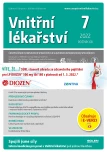Inflammatory markers in clinical practice
Authors:
Štefan Sotak
Authors‘ workplace:
I. interná klinika UPJŠ LF a UN LP v Košiciach
Published in:
Vnitř Lék 2022; 68(E-7): 11-16
Category:
Review Articles
doi:
https://doi.org/10.36290/vnl.2022.100
Overview
Inflammation is the general defense response of the body against various harmful irritations. Diagnosis of the inflammatory process and monitoring of its treatment is based on a combination of clinical and laboratory findings. Biochemical inflammatory markers usually serve to support the diagnosis of the infection, to monitor it, and to monitor the effectiveness of anti-infective treatment. The inflammatory marker should be selected according to the clinical condition with regard to the treachery and deficiencies of the markers, with knowledge of their dynamics and with regard to the length of the anamnesis. As an optimal procedure for detecting bacterial infection, it is recommended to screen for several acute phase proteins. The role of the physician is to determine when, under which circumstances, and which markers to have examined, with a view to ensuring that the patient is correctly diagnosed in time and receives appropriate treatment, and on the other hand, that he is not unnecessarily iatrogenized and that the medical facility does not lose money unnecessarily.
Keywords:
CRP – inflammation – marker – PCT – IL 6
Sources
1. Koporcová J. Súčasná laboratórna diagnostika zápalových stavov. inVitro. 2015;3(1):28-32.
2. Kožíková K. Pozícia vyšetrenia CRP v indikácii ATB liečby v praxi všeobecného lekára. Košice: UNLP Košice 2011 [cit. 2020-10-25]. Dostupné z WWW: <http://www.unlp.sk/index.php?option=com_content & task=view & id=1173 & Itemid=95>.
3. Fadi FG, Szalai AJ. C‑Reactive Protein Gene Polymorphisms, C‑Reactive Protein Blood levels and Cardiovascular Disease Risk. JACC 2007;50(12):1115-1122.
4. Vermeire S, Van Assche G, Rutgeerts P. Laboratory markers in IBD: useful, magic or unnecessary toys? Gut. 2006;55(3):426–431.
5. Biasucci LM, Koenig W, Mair J et al. How to use C‑reactive protein in acute coronary care. EHJ. 2013;34(48):3687-3690.
6. Nehring SM, Goyal A, Bansal P et al. C Reactive Protein, 2020. [cit. 2021-05-16]. Dostupné z WWW: <https://pubmed.ncbi.nlm.nih.gov/28722873>.
7. John JM, Bhatt DL. Emerging risk factors for atherosclerosis. Indian Heart J. 2007;59 : 28-37.
8. Prasad K. C‑reactive Protein‑Lowering Agents. Cardiovasc Drug Rev. 2006;24(1):33-50.
9. Seifert B. Diagnostika CRP. 2006 [cit. 2020-10-25]. Dostupné z WWW: <https:// www.euni.cz/kurz/2210-diagnostika‑crp?presenter=Lecture>.
10. Liu HH, Guo JB, Geng Z. Procalcitonin: present and future. Ir J Med Sci. 2015;3(184):597 - 605.
11. Zazula R, Průcha M, Spálený A et al. Prokalcitonin nejen v diferenciální diagnostice zánětlivé odpovědi organismu. Anest Intenziv Med. 2002; 2 : 86-91.
12. Ban HJ, Ji SG, Chi SY et al. Usefulness of Serum procalcitonin in lung cancer patients with elevated serum C‑reactive protein level. BSJ. 2011;38(55):2803.
13. Fournier T, Medjoubi‑N N Porquet D. Alpha-1-acid glycoprotein. Biochem Biophys Acta. 2000;1482(1-2):157–171.
14. Ďurovcová E. CRP a iné markery zápalu v klinickej praxi. Interná med. 2019;19(9):341-346.
15. Vlniešková K. Biochemické zápalové markery. NEWSLAB. 2016;7(1):62-64.
16. Astigarraga I, Ollauri ‑ Ibanez C, Garcia‑Obregon S et al. Hyperferritinemia is a bad prognosis factor in COVID-19 patients and it is not specific for HLH in adults. PBC 2021;68(S1):covidwho-1107599.
17. Taher MY, Davies, DM, Maher J. The role of the interleukin (IL)-6/IL-6 receptor axis in cancer. Biochem Soc Trans. 2018;46(6):1449–1462.
18. Uhlar CM, Whitehead AS. Serum amyloid A, the major vertebrate acute‑phase reactant. Eur J Biochem. 1999;265(2):501-523.
19. Gregorová E, Klímová M. Laboratorní příručka. 2021. [cit. 2022-09-25]. Dostupné z WWW: <https://www.nempt.cz/files/lab_prirucka/_LP_01523.htm>.
20. Malle E, De Beer FC. Human serum amyloid A (SAA) protein: a prominent acute‑phase reactant for clinical practice. Eur J Clin Invest. 1996;26 : 427-435.
21. Yamada T. Serum amyloid A (SAA): a concise review of biology, assay methods and clinical usefulness. Clin Chem Lab Med. 1999;37 : 381-388.
22. Hogarth MB, Gallimore R, Savage P et al. Acute phase proteins, C‑reactive protein and serum amyloid A protein, as prognostic markers in the elderly inpatient. Age Ageing. 1997;26 : 153-158.
23. Jabor A, Franeková J, Kubíček Z. Principy interpretace laboratorních testů. 2nd ed. Grada Publishing, a. s.: Praha 2020. ISBN 9788027112722.
24. Zavyalov VP, Hämäläinen‑Laanaya H, Korpela TK et al. Interferon ‑ inducible myxovirus resistance proteins: potential biomarkers for differentiating Viral from Bacterial Infections. Clin Chem. 2019;65(6):739-750.
Labels
Diabetology Endocrinology Internal medicineArticle was published in
Internal Medicine

2022 Issue E-7
Most read in this issue
- Differential diagnosis of leukocytosis and leukopenia
- Inflammatory markers in clinical practice
- Pegvisomant in the treatment of acromegaly
- Podiatric care from diabetologists point of view
